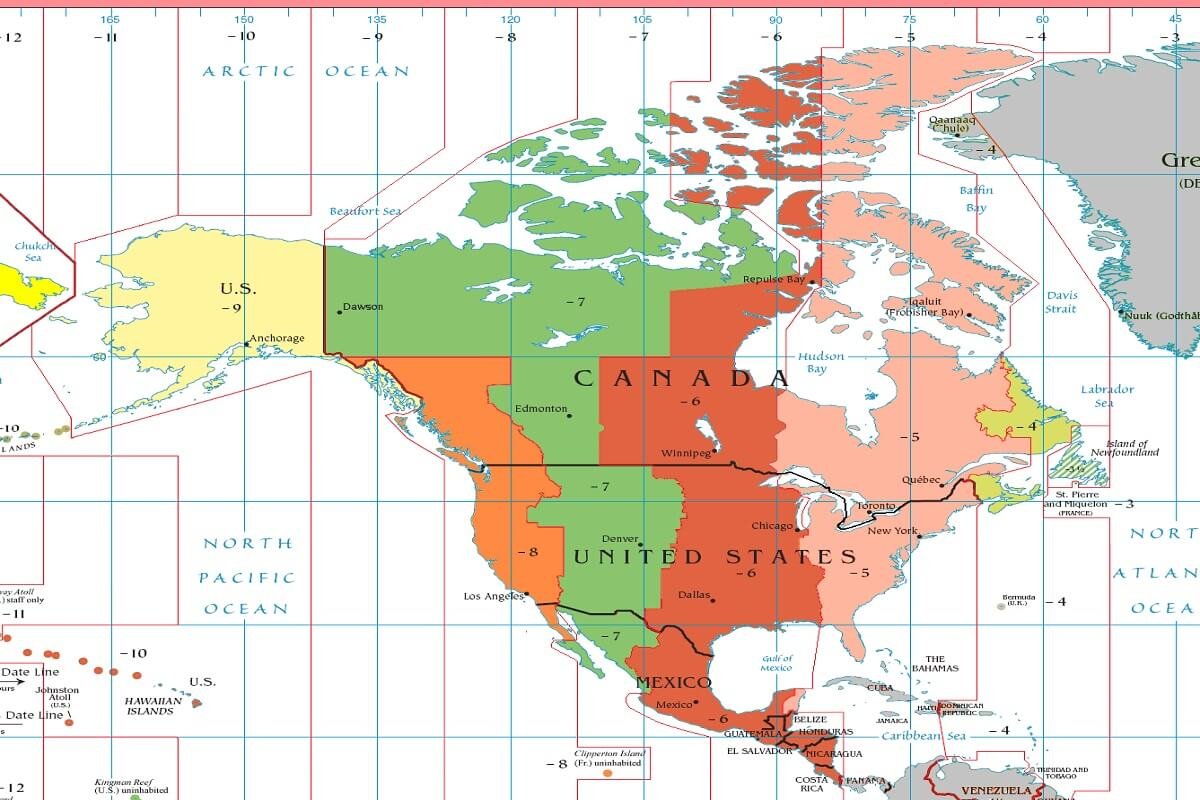The time zone for London is anchored in Greenwich Mean Time (GMT), which serves as the time standard for Western Europe. During the colder months, London maintains a time difference of five hours ahead of Eastern Standard Time (EST). When Daylight Saving Time is in effect, from the final Sunday in March to the last Sunday in October, this gap narrows to just four hours ahead of EST. It’s worth noting that not every country participates in Daylight Saving Time, which means their time offset with London may fluctuate over the course of the year.
Comprehending London’s time zone is crucial for coordinating teleconferences, video meetings, or phone calls with colleagues or friends who live in London. It’s also indispensable for travel arrangements and ensuring punctual arrivals. As London is a hub of historical richness and cultural vibrancy, adjusting your timepiece appropriately when you’re there is advisable.
Time Zone History of the United Kingdom
The United Kingdom was among the pioneer nations to adopt a uniform time standard across its territory, instead of allowing each locality to maintain its individual mean time.
In 1847, London transitioned from its local time to adopt Greenwich Mean Time (GMT), also known at the time as Railway Time. This standard was initially employed by the country’s rail companies. Until 1972, GMT served as the global benchmark for civil timekeeping. It was based on the solar time at the prime meridian, located close to the Royal Observatory in Greenwich. The contemporary global time standard, Coordinated Universal Time (UTC), still aligns with the prime meridian, marked at 0° longitude.
What Time Zone in London?
London follows two main time zones depending on the season. During the colder, winter months, it adheres to Greenwich Mean Time, commonly abbreviated as GMT. This time standard has a long history and is aligned with Coordinated Universal Time (UTC), without any additional hour offsets.
When the warmer, summer months roll around, usually from the last Sunday in March to the last Sunday in October, London transitions to British Summer Time (BST). BST is one hour ahead of GMT, effectively becoming GMT+1. This shift is part of the broader practice known as Daylight Saving Time (DST). The primary aim of DST is to make better use of daylight during the evenings, thereby saving energy.
To make this time adjustment, clocks in London are advanced by one hour at 1:00 a.m. GMT to become 2:00 a.m. BST in the spring. Conversely, in the autumn, the clocks are set back from 2:00 a.m. BST to 1:00 a.m. GMT, reclaiming the “lost” hour.
So, to summarize, London functions under GMT during the winter and shifts to BST, which is GMT+1, during the summer. This time-keeping approach is in line with many other countries that also observe some form of Daylight Saving Time.
What About BST?
British Summer Time is one hour ahead of Standard Time during Daylight Saving Time in the United Kingdom (BST). In the summer, only the United Kingdom observes British Summer Time. Other nations, including Ireland, observe the same local time under a different name.
Why do London’s clocks change?
In 1907, William Willett proposed changing the clocks. He desired to prevent the squandering of early morning light and to introduce brighter summer evenings.
British Summer Time was established by the Act of Parliament in 1916. With only a handful of exceptions, such as during World War II, the clocks have been advanced annually in March for the past century.
A London Time Landmark
Until 2017, visitors to central London and Londoners alike could determine the time in London and the rest of the United Kingdom simply by looking up near the Parliament. Possibly the most famous clock in the world, affectionately known as Big Ben, resides in the Elizabeth Tower, a magnificent tower.
Its chimes have always been as recognizable as its appearance. On August 21, 2017, at noon, Big Ben chimes rang out once more prior to the beginning of extensive maintenance work. These chimes were heard again on November 11th, Remembrance Day, and they rang in the year 2018. Big Ben will likely remain silent until 2021.
The British Parliament’s website features a section dedicated to Big Ben, which includes the most recent news and a timeline for the conservation project.
Would you like to see how many days have passed since the beginning of the year and how many days remain until 2023? Check out the Date Calculator.
When do clocks spring forward?
On the final Sunday of March, the time advances from 1 am to 2 am. When the clocks are advanced by one hour, the time is referred to as British Summer Time or Daylight Saving Time.
The Difference between GMT and UTC
In actuality, GMT and UTC share the same time on a clock, which can lead to confusion or interchange. Nonetheless, there is a significant distinction between the two:
UTC is a time standard that serves as the basis for time zones around the world but is not used as a time zone in any country. The definition of time zones is based on their offsets from UTC. Since the offset between GMT and UTC is zero, there is no difference in time between the two.
The United Kingdom and other European and African nations observe GMT.
Prior to the introduction of UTC, GMT was the world’s time standard, which is a source of confusion. Prior to 1972, time zones were determined by their difference from GMT based on the mean solar time at the prime meridian near Greenwich, England.
Converting Eastern Standard Time to London Time
This time zone converter allows you to convert EST to London, England time and vice versa in a straightforward and visual manner. Simply hover the mouse over the colored hour tiles and examine the hours selected by the column, and you’re done.
EST is the abbreviation for Eastern Standard Time. London time is 5 hours ahead of Eastern Standard Time. Therefore, when it is 11:00 am EST
It shall be 4 o’clock in London
Additional conversions: EST to Nairobi Time, EST to Hagatna Time, EST to Accra Time, and London Time to EST.
Why You Should Follow the London Time Zone When Travel?
Following London’s time zone when you’re traveling to or through the city is essential for several compelling reasons:
1. Punctuality: Being in sync with London’s time ensures that you arrive on time for flights, train departures, and other scheduled modes of transportation. This is especially crucial if you have tight connections or specific windows for check-in.
2. Accurate Planning: Activities like guided tours, museum visits, and dining reservations often adhere to strict schedules. Knowing the local time helps you plan your day effectively so that you can make the most of your trip.
3. Business Commitments: If you’re traveling for work, adhering to London’s time zone is vital for aligning with local business hours, making it easier to schedule meetings or catch up on work without confusion.
4. Avoiding Jet Lag: Gradually adjusting your internal body clock to London time before you arrive can help mitigate the effects of jet lag, allowing you to enjoy your trip more fully right from the start.
5. Cultural Events: London is renowned for its cultural activities, such as theatre shows, concerts, and sporting events, all of which run on local time. Being in tune with the local time zone ensures you won’t miss out.
6. Local Customs: Understanding the local timing can help you blend in better with the culture. For example, knowing when typical meal times are or when shops are open can make your trip more enjoyable and convenient.
7. Communication: If you need to stay in touch with people back home or in other time zones, knowing London’s time will help you coordinate communications more easily.
8. Emergency Situations: In case of an emergency, being on the local time ensures you know when services like hospitals or embassies are open and available to assist you.
9. Public Transport: London’s public transportation system, including buses and the Tube, run on schedules tied to local time. Being off even by a small margin could lead to delays or missed opportunities.
10. Maximizing Experience: When you’re in sync with the local time, you’re more likely to maximize your experience, catching the sunrise at iconic locations or experiencing the city’s nightlife to its fullest.
Adhering to London’s time zone can significantly improve the quality and convenience of your trip, whether it’s for business or leisure.
Frequently Asked Questions (FAQs)
What time is it in the United Kingdom?
In the United Kingdom, it is currently 1:00:05 am. The date is the 17th of September, 2022.
Does the time in London change?
When do the clocks in London change? In the United Kingdom, the clocks are adjusted twice per year. In March, the clocks are advanced by one hour for British Summer Time, and in October, they are set back by one hour. Remember the helpful phrase “spring forward, fall back” if you are unsure of which direction the clocks are changing.
How long is London ahead of New York by four hours?
There is a five-hour time difference between London and New York.
Does London support dual time zones?
London observes Greenwich Mean Time (GMT) in the winter and British Summer Time (BST) in the summer.
Which nation features the most time zones?
France, including its overseas territories, has 12 time zones, the most of any country (13 including its claim in Antarctica).
Which country is behind in time?
Which nation are the most behind schedule? Baker Island Time (BIT; UTC-12), the time on Baker and Howland Islands, is the time zone with the most significant time difference.
Read More:
1st Largest Island in The Philippines
How to Shower When Car Camping?
Exploring the Beautiful City with Barcelona City Tour Hop On Hop Off
What is Travel Enthusiast: Best 35 Ways Become a Travel Enthusiast









[…] Read More: What Time is it in London […]
help for essay writing
What Time is It in London? – Travel in Planet
[…] Related: What Time is it in London […]